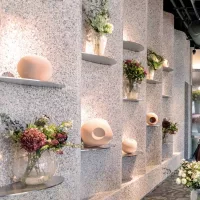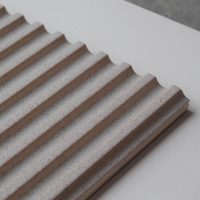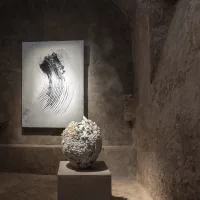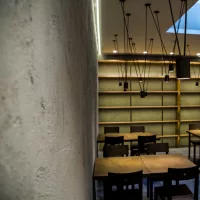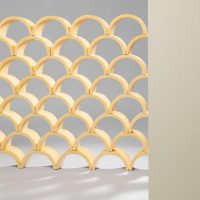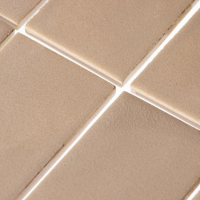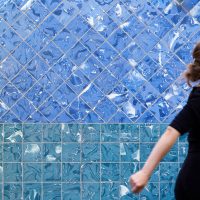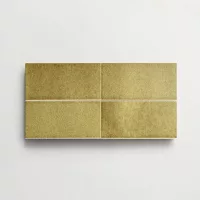MATERIALS LIBRARY
Clay & Ceramics
Discover the finishes and techniques from our craftsmen, artisans and makers.
From handmade ceramics to bespoke metal finishes.
Home » Clay & Ceramics
Clay & Ceramics
Explore our curated selection of Clay Plasters, artisanal Cotto, and Ceramic Tiles. Immerse yourself in our eco-friendly clay finishes for a refined interior touch.
Explore our diverse range of clay plasters, handcrafted Cotto tiles, and ceramic tiles. Dive into the world of natural, environmentally friendly clay products to beautifully finish your interior spaces. From fluted tiles to captivating 3D tiles, our collection offers a wide array of options for both indoor applications and facades. Embrace the charm and sustainability of clay with our high-quality products, designed to bring a unique aesthetic and texture to your surroundings. Discover the versatility of clay and transform your space with our exquisite offerings.
FAQs
What is clay made of and what are its main components?
Clay is primarily composed of hydrous aluminium phyllosilicates, along with various minerals, including quartz, metal oxides, and organic matter. Our clay is derived from raw earth and it is 100% natural, sourced from clay quarries located in Europe.
What are the basic elements and materials that make up clay?
Clay is primarily made of fine-grained natural soil materials that exhibit plasticity when wet. Its fundamental components include minerals such as kaolinite, illite, and montmorillonite, in addition to various other minerals and organic substances that contribute to its unique properties. These attributes make clay a material that is easy to apply.
What is clay raw material?
Clay raw material refers to unprocessed clay extracted directly from the earth, serving as a fundamental resource for various applications. This natural material is characterised by its fine-grained texture and plasticity when wet, making it suitable for a wide range of uses. Once harvested, clay can be refined and processed to meet specific requirements for products such as pottery, tiles, bricks, ceramics and construction materials. We use clay finishes and ceramics that are suitable for architecture and interior applications.
Is clay mined and how is it extracted?
Yes, clay is typically mined from the earth. The mining process involves extracting clay deposits from various geological formations. It is not mined through a complex quarrying process like marble and other stones. Caly can be found in relatively shallow deposits, making it easier to extract without extensive excavation.
Why is clay considered a sustainable and eco-friendly material?
Clay is a naturally abundant resource that can be sourced from the earth with minimal environmental impact, especially when extracted responsibly. Unlike materials derived from fossil fuels, clay is renewable and can be replenished over time through natural processes. Clay is non-toxic and low VOC, making it an eco-friendly choice for products such as ceramics tiles and construction materials.
Can clay come in different colours?
Yes, clay comes in a variety of natural colours, depending on the minerals present in the clay. Our clay finishes derive their unique colours from the natural minerals within the clay itself, without the need for added pigments. Because the colours are naturally derived from minerals, they remain consistent during application and throughout the product's lifetime. Unlike synthetic pigments, which may fade over time, the mineral-based colours of our clay finishes retain their original appearance, providing a long-lasting and environmentally friendly finish.
Can clay be used indoors?
Yes, clay can be used indoors. Our clay finishes can be applied to walls, ceilings, wet areas, and floors. These natural finishes offer a beautiful, durable surface while promoting healthier indoor air quality due to clay being a hygroscopic material.
Can clay be used outdoors?
Yes, our clay finishes can be used outdoors. They are suitable for a variety of exterior applications, such as facades for residential houses or retail store fronts.
Can clay be used in commercial spaces?
Yes, clay can be a great choice for commercial spaces. We offer a variety of clay finishes tailored to different applications, including displays, furniture and flooring. For more detailed information reach out to us at info@materialsassemble.com
Is clay good for human health?
Yes, clay is beneficial for human health, especially when used as a building material or finish in interior spaces. Our clay finishes are naturally low in VOCs, which means they don't emit harmful chemicals into the air. This contributes to healthier indoor air quality, reducing the risk of respiratory issues or allergic reactions. Additionally, clay has naturally humidity regulating properties, helping to maintain a comfortable and healthy environment.
What is the most common ceramic material used in construction?
The most common ceramic material is fired clay, widely used in various products such as bricks, tiles and structural elements. Fired clay is valued for its durability, heat resistance and versatility, making it a fundamental material in both traditional and modern applications.
What are the main types of ceramics?
The three main types of ceramic are:
Earthenware: Fired at low temperatures, earthenware is porous and less durable, making it ideal for interiors and decorative walls. It is often glazed to improve water resistance.
Stoneware: Fired at higher temperatures, stoneware is more durable and water-resistant than earthenware. This makes them more suitable for exterior applications.
Porcelain: Fired at the highest temperatures, porcelain is known for its dense, glass-like finish and superior strength. It’s used in fine china, tiles, and high-end ceramics due to its durability, translucency, and smooth surface.
What is the most common ceramic material?
Yes, ceramics are highly suitable for use in commercial spaces due to their durability, versatility, and aesthetic appeal. They can be used in a variety of applications, including flooring, wall coverings, countertops, and fixtures. Ceramic tiles are particularly popular in high-traffic areas like retail stores, restaurants, and offices, as they are resistant to wear and easy to maintain.
Can ceramics be used outdoors?
Yes, ceramics can be effectively used outdoors, particularly for facades. Our ceramics are specifically designed to withstand outdoor conditions, making them ideal for use on building facades, patios, walkways, and pool areas.
These ceramic materials not only offer durability but also enhance the aesthetic appeal of any structure with a variety of colours, styles, and finishes. Proper installation and maintenance will ensure that our ceramic facades remain functional and visually striking for many years.
Sustainability
- EPD Certificate (53)
- Low VOC (84)
- Natural Materials (36)
- Recycled Materials (24)
- Zero-Waste (1)
Use
- Indoor (212)
- Covering (1)
- Floor (79)
- flooring (8)
- Furniture (1)
- Outdoor (145)
- Vertical surfaces (6)
- Wall (162)
- Wall cladding (5)
- Walls (14)
- Waterproof (105)



